Yes, we’ve finally got to that point where we had to put together a comprehensive design for how combat works in Clockwork Empires. So let’s talk a bit about it.
We’ve all played lots of games and almost all of them are about combat in one way or another so this seems like it should be a fairly straightforward problem to solve. But CE is not like most games; Not at all. Combat is not the central game mechanic and focus for the game, merely one possible component in a much larger system. It can’t be allowed to take over the game and unduly tax a player’s attention, nor should it be irrelevant or some kind of tacked-on side-game as seems to be the pitfall of combat systems for a number of classic city-builder games. In CE, combat should tie in with as many other game systems as possible so that it supports the other mechanics in play and in doing so enriches the overall experience. Simple enough, eh!
With those requirements in mind I tried to sum up CE’s take on combat in a sentence: “Combat should be slow, mostly positional, and have its outcome determined by supply and setup instead of tactical micromanagement.”
The pace shall be deliberately slow so a player can take the time to properly assess the effects of their decisions and have time to adapt their strategy to failures. (And besides a slower pace, the game can be paused outright in the manner of tactical combat in classics like Baldur’s Gate or Darklands.) Outcome determined by supply and setup instead of moment-to-moment Starcraft-style micromanagement means decisions most important to the outcome of combat can be made well ahead of time. This makes it a game of strategy over tactics, and tactics over twitch. To further that point, as is proper in a city-builder game, thoughtful positioning is everything: just as it’s important where the mines are built in relation to the middle class housing and the metalworks, just so it is important to be mindful of the placement of your defensive wall, the artillery squad, and Steam Knight patrols. Rather than a reflex AWP shot, think of it more like gardening, albeit bristling with barbed wire and Redcoats.
The Chain of Command & Command Disposition
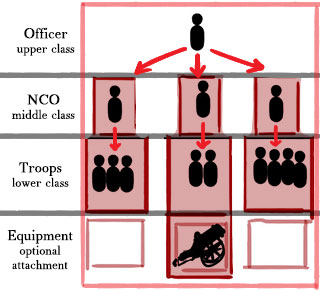
Mjr. General Ogden Cogsbold’s timid manner is reflected in the behaviour of the entire regional military.
Clockwork Empires is a game about characters, not just the cold mechanics of supply chains and industry. Therefore the character of your soldiers must be essential to the outcome of combat. In the post about overseers and work crews it was implied that the character of an overseer is reflected in the performance of the work crew they lead. It’s just the same for military squads with NCO and officer leadership of military squads having an even greater effect which we call “Command Disposition”. And I daresay, the hierarchical theme of top-down leadership fits nicely into 19th century military doctrine.
Now, the Command Disposition — in addition to how a squad is manned — can act a bit like scripting orders for squads like some kind of really lightweight version of Dominions 3 tactical combat. Assign a bookish and stubborn NCO to a squad and they’ll tend to be defensive and stick to their trenches. Assign an aggressive, violently-inclined NCO to the same squad and they become more likely to order a bayonet charge against the enemy. There’s a bit more to it than that of course; equipment has an effect, so Steam Armour equipped squads will be used for the role of assaulting defenses and artillery equipped squads will stay back and merrily bombard the enemy.
(I will also admit here that the random leader personality trait generation of Paradox‘s Victoria as well as Hearts of Iron III’s command structure system have had a good bit of effect on my thinking.)
It is worth stating of course that the personalities and interactions of characters is a whole system unto itself which has effects that are felt in combat which is a subject which deserves a post of its own.
Managing Defeat
For many combat games, once the sequential play-through has its reloads trimmed off, the timeline looks like a straight line of victory after victory after victory. The player has power over some kind of quantum multiverse which allows them to select the timeline in which they won every battle. In contrast, we want players of Clockwork Empires to be able to fail, but we want it to be a rewarding experience to fail. As we keep saying in interviews, “Things going spectacularly wrong makes a great story.” Remember the Alamo, the Charge of the Light Brigade, the Battle of Isandlwana, and Dredmor’s planned release date!
Defeat should be a bloody good story. A player who keeps a stiff upper lip and endures defeat should be rewarded with narrative richness. And that said, we game designers should be nice enough not to punish them by making their entire game collapse because a squad of soldiers had a bad day. So we must soften defeat from the traditional red mist and bone chips model that’s had such a strong tradition in games.
So: Combat won’t be a meat-grinder. The Starcraft-style RTS has its soldiers eagerly fighting to the death – and always to the death. In CE an individual character’s willingness to fight affects whether they will actually stick around to fight. Sometimes a coward is a coward, but a player can stack the odds in their favour by choosing the right military leadership, setting their squads in good defensive positions, keeping troops well supplied, and doing everything else they can to keep moods positive.
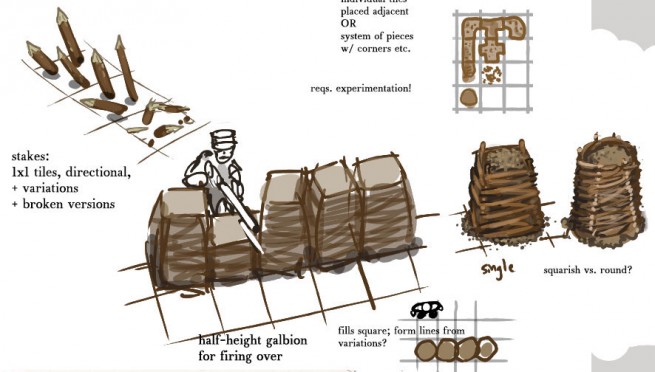
Concepts for field fortifications based on American Civil War era gabions which I spelled “galbion” and know is incorrect so no one has to correct my spelling now, thanks.
It must be said that with all the character-driven action in mind, there’s very much a balance to be struck between characters’ willingness to follow orders and the player being able to actually play the game in any meaningful sense. This goes for civilians as well because if your lumberjacks are more interested in dancing jigs and drinking gin than ever getting to work, this game is going to get really frustrating.
Back to the subject of defeat: Even victory can be made expensive to slow down runaway success. Combat actions wear down characters’ stamina, and suppressing fire saps willingness to act – perhaps in the manner of Jagged Alliance 2 in which suppressing fire would actually reduce action points. When in a tight spot, buy some time with ammunition! (Though supplies are limited and must be properly restocked.) Further, the best combat positions are of course immobile defensive works in the grand tradition of something between the American Civil War and World War 1. Anything strong enough to punch through those static defenses, be it artillery batteries or Steam Knights, requires a solid supply of fuel and munitions which in turn requires careful use of terrain, guarded flanks, and measured advances. (By the way, these logistical themes are explored elegantly in Unity of Command. Hi Tomislav!)
Right! Well, there’s more to it than all that: equipment, types of soldiers, the exact personality traits which affect combat, types of units via squad equipment attachments, the role of armour and artillery and static defenses, psychological effects of combat, and of course how the heck the UI for all of this is going to work. It’s all very early in the design process and what we’ve got here is largely a statement of goals & high-level plans for how to meet those goals using the other systems in the game as a framework. The details are very much subject to iteration as the game hits testing so there’s not much use in getting into the gritty specifics. But in all I hope this has given you an idea about where we’re planning to go with combat in Clockwork Empires.
Q. What, no cavalry? A. Not on horses, no. The Gaslamp Way does not involve doing anything so mundane. Plus it’s actually really hard to animate horse cavalry properly in limited space. The Mount & Blade or perhaps Total War series are about the closest you’re likely to get at this point. That said, keep in mind: Nothing So Mundane As That.
Q. Are there tanks? A. Of course, because what else would Steam Knights keep their high-pressure steam in? (Surely you’re not referring to those burdensome Stahlmarkian Landkreuzers?)
Q. Can you fight your friends in multiplayer? A. Naturally, and didn’t we cover this already? Every Gaslamp Games Press Release is Totally Serious About Everything.

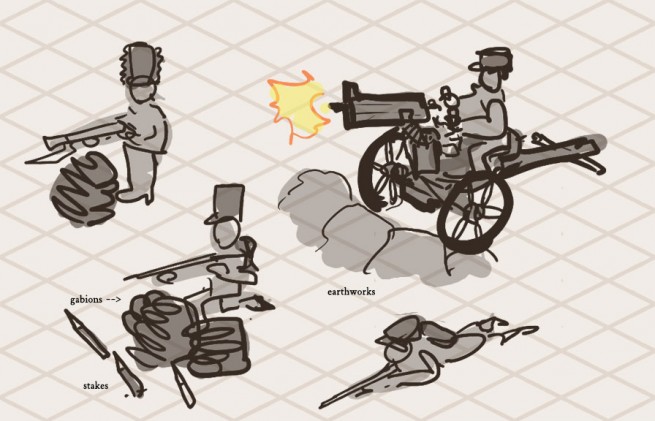
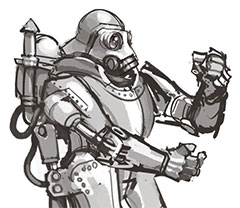
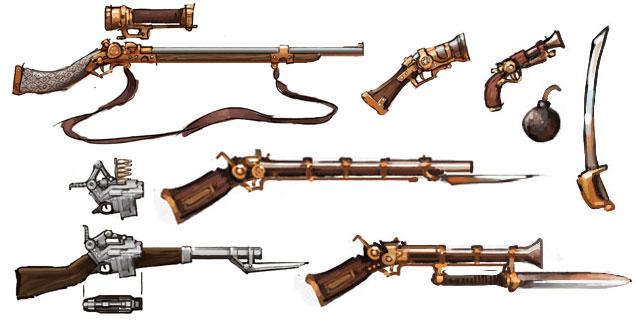
However tenuous, references to Darklands are always awesome.
YES. Everything about this. YES. 🙂 Love the art! That mime steam knight cracks me up, and the guns look very awesome.
THANK YOU!
Also kudo’s for mentioning Unity of Command.
You guys are great and I read every post. That is all.
Oh and I was curious, from whence does your affected victorian/steampunk English vocabulary and sentence construction spring from? I know a good chunk is coming from Lovecraft, but was curious to know if you have specific inspirations for your mad utterances.
Speaking for myself, a huge part of it is that I *always* write run-on sentences and abuse vocabulary because I think it’s fun. Also: China Mieville. Especially the recent abuse of ampersands is from his book “Railsea”.
Ha! Nice.
Also: Railsea was fantastic and China Mieville should be given another award, like an award box to hold all the awards.
Awesome post. I noticed that you are avoiding talking about the (admitedly difficult) matter of player interaction. How much granularity do you envision for the player actions on the battlefield? Will he maybe only manage the Officers? Could the player order, say, a round of suppressing fire at a given moment? Who decides when and where to throw the Holy Grenade of Antioch?
A proposal for interaction was written up but I didn’t want to get into it because the post was running long.
But hey, we’re in the comments now, so: Individual combat actions like a cooldown-limited suppressing fire action are not planned. This sort of thing would be determined by the NCO/squad AI; We don’t want the player to have to manage timing like that. The player does however manage NCO/Officer assignment and the officer traits may determine use of suppressing fire.
Basically, the player should be setting policy rather than initiating individual actions.
Now that sounds like a very interesting to strategy warfare. Determining the overall strategy and then hoping the men don’t botch it up.. too badly.
Though i suppose question becomes, how many abilities can they have, will training and equipment play a role ?
I think at the end you will need to extend it a bit more than “general policy setting”. Most players will want some degree of control over their squads.
But I have been wrong before, and I would love to be proven wrong on this case. I will continue stalking you and muttering poignant questions here, good luck!
Current design has general positioning and facing under player control — or, at least, you can order a squad to be somewhere and orient in a certain way, then it’s up to them to actually do it. The micromanagement of combat actions like “fire volley” or “throw grenades then charge!” is the sort of thing you won’t explicitly control because they’re time-based and that’s the sort of twitch action I want to get away from having to worry about.
Oh, being able to position squads is the kind of thing I was talking about. I didn’t want to have a “I want someone to patrol this area” order, but a “hey, your squad has a lot of defense points, go patrol here” order. I profoundly dislike twitchy gameplay, so I’m 100% behind you guys 🙂
“barbed wire and Redcoats” – made me think of the other kind of redcoats. Teehee!
Sounds like a good direction for combat. I hated how it worked in games like Caesar 3 and Settlers, and just tried to avoid it. Equipping people and letting them largely get on with it on their own sounds much better. 😀
An excellent way to tie the building aspect to the combat aspect is indeed supply. If rifle cartridges are made actual items that are required to shoot a firearm, then the colony that runs out of cartridges is probably only little better off than a colony that runs out of soldiers.
The quality of rations, barracks, equipment and possibly the availability of luxury items such as alcohol and tobacco could also influence the combat effectiveness of soldiers.
If food consumption vs food production per capita is tightly balanced, then fielding a large military will only be possibly with investment into machinery that increases food per capita, freeing up farmers for other tasks.
I think the main point was not 100% clear, so:
The idea behind making rifle cartridges actual items that are consumed is that the colony will need to dedicate some of its production to rifles cartridges if it wants to have an effective military.
The gatling gun in the concept art looks pretty ammo intensive also.
Indeed: You can produce ammunition yourself or make sure you have open trade routes to import it. And yeah, having nice “vice” goods for your soldiers like booze, coffee, and tobacco means that combat effectiveness is enhanced by playing the rest of the game well, having effective farms, factories, and trade, which is all the better for tying systems together.
Today’s Special: A cold Red Mist bisque with Bone Chips and a Diggle Marrow Bruschetta.
Today’s Prize: A cold Red Mist bisque with Bone Chips and a Diggle Marrow Bruschetta.
Yes… YES. Peeaz, the god of blood and pain and weswearhesnotaKhorneripoff, is pleased with this prize. Sign his priests up for the raffle.
While combat in the multiplayer game is somewhat exciting prospect, I hope gaslamp enables the players by have a large variety of non-combat oriente ways to destroy their opponents. Things like brainwashing enemy citizens into becoming nightstalking vampires that feed on ultra-safe steam (plentiful in their home towns), or sending a tribute (and eldritch) butter churns to their bakeries. This is what will ultimately create for a rich PvP stories, not the battles that were had, but the chaos that was being sown in the background while the frontlines were stale-mated in trench warfare.
My hope here is that there is enough diversity in map generation that a player can’t think ‘oh, I am gonna use this strategy’ as soon as they load the game up, and yet allow the creative player to cause enough trouble that the warminded player cannot continuously be dumping resources into their army without constantly diverting attention to these non-combat dilemmas.
A proper balance in this regard is a lofty goal, but I believe gaslamp has what it takes.
That would be interesting, but it’d also be necessary to make sure that warminded societies are able to beat other colonies without resorting to sabotage. Variety is important; by making it so that one society can just make all one’s civilians go insane and blow everything up, they’d be strongly encouraging players to focus on doing that, rather than building a military and invading the old fashioned way.
Besides, eldritch artefacts do not seem to be particularly popular in the Clockwork Empire.
I’ve been interested in this game since it was announced and have followed it nearly religiously. Despite great stories, very interesting ideas, and other such stuff, NOTHING HAS EXCITED ME MORE THAN THIS LINE.
“Further, the best combat positions are of course immobile defensive works.”
Thank you. It’s one of my favorite things of AoE2 games: building huge intricate arrays of castles and walls and towers and sitting back to see if my brother could get past them. Then you go and throw in logistics? To quote somebody, I think it was Rommel:
“Novice strategists study tactics. Masters study logistics.”
“–and geniuses study both.”
I’m almost certain whoever it was you were quoting said that.
The more i look, the more he looks like a tesla trooper. Also yay for non twitch combat.
So excited about this. Dungeons of Dredmore was my favorite indie game last year, so can’t wait to see what Gaslamp produces with Clockwork Empires. It will be a definite ‘must buy’ for me 🙂
Pingback: Clockwork Empires combat to favour strategy and tactics over “twitch” | VG247
Love the combat mechanism ideas, if you guys manage to pull this off as well as you make it sound then this will definitively be one of the few games I don’t kill my fun by save-reloading. <3
Also, makes me very excited to know what possible enemies our colonies get to face. :3
Nothing as mundane as horses leads me to think of some sort of motorized two wheel machine. The mechanics look excellent as always.
You know, this system sounds like it would lend itself to simulating urban revolts, with revolutionaries and barricades in the streets. That might make for some fun scenarios.
Dungeons of Dredmore is my favorite indie game, i am so excited about this, thanks 🙂
“This makes it a game of strategy over tactics, and tactics over twitch.”
I love you all.
Ha. This reminds me very much of Dwarf Fortress – now THAT is some interesting combat (if you can stand ASCII – this game is just beautiful and I don’t mean to compare ‘graphics’ at all).
The feeling of having your little guys go running to their deaths or running screaming for safety under their own steam (no pun intended) is actually so much more fulfilling than dragging a box around a group of dudes and right clicking somewhere it’s ridiculous. Star Craft is actually a little outdated in terms of squad AI in that the units have a tendency to just do only what you tell them to and shoot things that come close.
The idea of the officers having an effect on their men is also good, depending on leadership qualities. Automated micromanagment of troops, too? Like a guy who’s been in ten battles and missing an arm… he more grizzled?
And what about wounds? Just 100 hitpoints and they’re out or will there be the potential for targeted crippling and the errant headshot to derail everything?
Leaving it open to take punitive action against ineffective officers would also be nice.
I really like the idea that the relationships and traits of individual units have an effect on their reactions (and probably tactics) in battle. It’s certainly fresh and interesting.